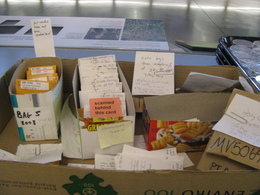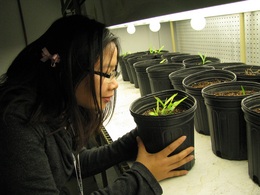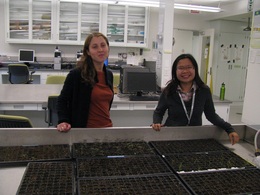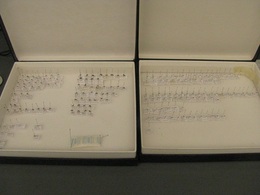|
|
Every year the Echinacea Project collects all of the flowering heads from the experimental plots and processes them in the lab. Considering this process managed and completed by different people every year, it is challenging to keep everything organized from year to year.
One of our goals this year is to wrap up data collection on Echinacea seed heads from 2009 to 2011. Last year, Northwestern students Karen Taira and Ricky Rivera spent many hours organizing data from 2009 and 2010. They solved a lot of mysteries, including mislabeled heads, mislabeled files, and files saved in weird places. Last week I picked up where they left off. We are down to one box of mysteries–seeds that still need to be scanned, counted, and weighed. Once we finish with this box, we will have all our data from 2009.

In other news, a class from Lakeforest College is coming to the Chicago Botanic Garden for a mini-internship program. Karen, Stuart, and I will all be mentoring students for the next few weeks in projects related to our research. We will introduce the students and update their progress on the flog.
Lastly, this week we said goodbye to volunteer Art Abt as he prepared for his winter migration to warmer climes. We will miss him and his expertise in seed weighing.
Photo of scanned achenes. The dot indicates that the achene has been counted. The pencil shaped item in the center of the image is the counting tool. Place the point on a achene and hit the enter key and the “dot” is placed as well the count increased.

Suzanne Turner foing inventory on 2012 Echinacea harvest.

Bill Wallin Counting

Based on the flog, it may seem that the lab activity has been consumed with counting seeds and identifying ants. However, I should point out that there are some real live plants in the lab as well.
Maria has been lovingly tending her Dicanthelium plants that she germinated last fall. One of the perks of working at the Chicago Botanic Garden is the high-tech growth chamber that allows you to control light, temperature, and humidity on a programmed schedule. Maria has programmed the chamber to approximate fall in Minnesota.

Any one at CBG can use the growth chamber for their research. Anna Braum, a grad student at Northwestern, is growing host plants for her experiment on the parasitic plant Castilleja coccinea–also known as the indian paintbrush. Here she is watering her plants (with help from Maria).

Bill Wallin counting Echinacea achenes (2011).

Charlynn Schweingruber making a random sample of achenes (2011) for weighing.

We made a lot of progress this week. First, the volunteers finished the first round of counting for one of the larger experimental plots. There are still two more rounds of counting to finish, but we’re mostly there.
Suzanne started taking inventory of the heads we harvested this year. It didn’t take her long to get through everything, considering flowering was so low this year. Out of about 500 heads, there was only one that was mislabeled. There were a few missing, but they are on their way back from Minnesota.

I’ve been busy trying to identify all the ant specimens we have pinned. Right now it looks like we have two species of Lasius, five species of Formica, and one species each in several other genera. There are also multiple species within the genus Myrmica, but I haven’t identified them yet. Apparently that genus is particularly difficult to identify.
This summer, REU student Jill Gall put together a large collection of ants from prairie remnants in Minnesota. Yesterday, Stuart and I headed over to Lakeforest College to seek the advice of resident ant ecologist Sean Menke. Jill left us with two boxes of ants, which she pinned and identified to genus and separated into morphotypes:

Sean was impressed with her identification skills: she was correct in nearly every identification to genus and many of her morphotypes were consistent. He gave us some tips on what traits to look for when identifying ants. Now we have a plan for going through the rest of the collection. This will allow us to compare the species diversity of ants among prairie remnants, and hopefully pave the way for future ant research in the lab.

|
|


-thumb-260x202-136589.jpg)
-thumb-260x195-136585.jpg)
-thumb-260x202-136579.jpg)
-thumb-260x202-136574.jpg)


-thumb-260x202-136086.jpg)



